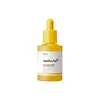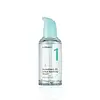What's inside
What's inside
 Key Ingredients
Key Ingredients

 Benefits
Benefits

 Concerns
Concerns

No concerns
 Ingredients Side-by-side
Ingredients Side-by-side

Water
Skin ConditioningNiacinamide
SmoothingButylene Glycol
HumectantJojoba Esters
Emollient1,2-Hexanediol
Skin ConditioningCurcuma Longa Root Extract
MaskingCaprylic/Capric/Succinic Triglyceride
EmollientCoco-Caprylate/Caprate
EmollientKojic Acid
AntioxidantAmmonium Acryloyldimethyltaurate/Vp Copolymer
Hydrogenated Castor Oil/Sebacic Acid Copolymer
EmollientMelia Azadirachta Flower Extract
Skin ConditioningOcimum Sanctum Leaf Extract
Skin ConditioningCoccinia Indica Fruit Extract
Skin ConditioningEclipta Prostrata Extract
Skin ConditioningMelia Azadirachta Leaf Extract
Skin ConditioningAllantoin
Skin ConditioningCetyl Alcohol
EmollientSilica Silylate
EmollientSodium Citrate
BufferingEthylhexylglycerin
Skin ConditioningCorallina Officinalis Extract
Skin ConditioningAdenosine
Skin ConditioningChamaecyparis Obtusa Wood Oil
MaskingBehenyl Alcohol
EmollientArginine
MaskingCitric Acid
BufferingTocopherol
AntioxidantPanthenol
Skin ConditioningSqualane
EmollientThioctic Acid
AntioxidantGlycolic Acid
BufferingWater, Niacinamide, Butylene Glycol, Jojoba Esters, 1,2-Hexanediol, Curcuma Longa Root Extract, Caprylic/Capric/Succinic Triglyceride, Coco-Caprylate/Caprate, Kojic Acid, Ammonium Acryloyldimethyltaurate/Vp Copolymer, Hydrogenated Castor Oil/Sebacic Acid Copolymer, Melia Azadirachta Flower Extract, Ocimum Sanctum Leaf Extract, Coccinia Indica Fruit Extract, Eclipta Prostrata Extract, Melia Azadirachta Leaf Extract, Allantoin, Cetyl Alcohol, Silica Silylate, Sodium Citrate, Ethylhexylglycerin, Corallina Officinalis Extract, Adenosine, Chamaecyparis Obtusa Wood Oil, Behenyl Alcohol, Arginine, Citric Acid, Tocopherol, Panthenol, Squalane, Thioctic Acid, Glycolic Acid
Water
Skin ConditioningButylene Glycol
HumectantNiacinamide
SmoothingGlycerin
HumectantDipropylene Glycol
Humectant1,2-Hexanediol
Skin ConditioningPanthenol
Skin ConditioningSophora Angustifolia Root Extract
Skin ConditioningAcrylates/C10-30 Alkyl Acrylate Crosspolymer
Emulsion StabilisingPropanediol
SolventDiethoxyethyl Succinate
SolventTromethamine
BufferingHydrogenated Lecithin
EmulsifyingAmmonium Acryloyldimethyltaurate/Vp Copolymer
Betaine
HumectantPantothenic Acid
Skin ConditioningTrehalose
HumectantEthylhexylglycerin
Skin ConditioningGlyceryl Oleate
EmollientSodium Phytate
Allantoin
Skin ConditioningAlpha-Arbutin
AntioxidantHouttuynia Cordata Extract
Skin ConditioningLauryl Glucoside
CleansingMyristyl Glucoside
CleansingPolyglyceryl-6 Laurate
EmulsifyingZinc PCA
HumectantMelia Azadirachta Leaf Extract
Skin ConditioningTocopherol
AntioxidantGlycyrrhiza Uralensis Root Extract
Skin ConditioningMelia Azadirachta Flower Extract
Skin ConditioningCoccinia Indica Fruit Extract
Skin ConditioningCentella Asiatica Extract
CleansingSodium Hyaluronate
HumectantCitric Acid
BufferingSolanum Melongena Fruit Extract
Skin ConditioningBeta-Glucan
Skin ConditioningOcimum Sanctum Leaf Extract
Skin ConditioningHyaluronic Acid
HumectantDecyl Glucoside
CleansingCurcuma Longa Root Extract
MaskingCorallina Officinalis Extract
Skin ConditioningDipotassium Glycyrrhizate
HumectantHydrolyzed Hyaluronic Acid
HumectantSimmondsia Chinensis Seed Oil
EmollientCamellia Sinensis Leaf Extract
AntimicrobialCentella Asiatica Leaf Extract
Skin ConditioningCladosiphon Okamuranus Extract
Skin ConditioningSalix Alba Bark Extract
AstringentSodium Acetylated Hyaluronate
HumectantCoffea Arabica Seed Extract
MaskingBeta-Sitosterol
Emulsion StabilisingPolyglyceryl-10 Stearate
Skin ConditioningCitrus Aurantium Bergamia Leaf Extract
AstringentPinus Densiflora Leaf Extract
AntimicrobialWater, Butylene Glycol, Niacinamide, Glycerin, Dipropylene Glycol, 1,2-Hexanediol, Panthenol, Sophora Angustifolia Root Extract, Acrylates/C10-30 Alkyl Acrylate Crosspolymer, Propanediol, Diethoxyethyl Succinate, Tromethamine, Hydrogenated Lecithin, Ammonium Acryloyldimethyltaurate/Vp Copolymer, Betaine, Pantothenic Acid, Trehalose, Ethylhexylglycerin, Glyceryl Oleate, Sodium Phytate, Allantoin, Alpha-Arbutin, Houttuynia Cordata Extract, Lauryl Glucoside, Myristyl Glucoside, Polyglyceryl-6 Laurate, Zinc PCA, Melia Azadirachta Leaf Extract, Tocopherol, Glycyrrhiza Uralensis Root Extract, Melia Azadirachta Flower Extract, Coccinia Indica Fruit Extract, Centella Asiatica Extract, Sodium Hyaluronate, Citric Acid, Solanum Melongena Fruit Extract, Beta-Glucan, Ocimum Sanctum Leaf Extract, Hyaluronic Acid, Decyl Glucoside, Curcuma Longa Root Extract, Corallina Officinalis Extract, Dipotassium Glycyrrhizate, Hydrolyzed Hyaluronic Acid, Simmondsia Chinensis Seed Oil, Camellia Sinensis Leaf Extract, Centella Asiatica Leaf Extract, Cladosiphon Okamuranus Extract, Salix Alba Bark Extract, Sodium Acetylated Hyaluronate, Coffea Arabica Seed Extract, Beta-Sitosterol, Polyglyceryl-10 Stearate, Citrus Aurantium Bergamia Leaf Extract, Pinus Densiflora Leaf Extract
 Reviews
Reviews

Ingredients Explained
These ingredients are found in both products.
Ingredients higher up in an ingredient list are typically present in a larger amount.
1,2-Hexanediol is a synthetic liquid and another multi-functional powerhouse.
It is a:
- Humectant, drawing moisture into the skin
- Emollient, helping to soften skin
- Solvent, dispersing and stabilizing formulas
- Preservative booster, enhancing the antimicrobial activity of other preservatives
Allantoin is a soothing ingredient known for its protective and moisturizingg properties. Because of this, it is often added to products with strong active ingredients.
Studies show higher concentrations of this ingredient can promote wound healing.
Though it can be derived from the comfrey plant, allantoin is produced synthetically for cosmetic products to ensure purity.
Learn more about AllantoinAmmonium Acryloyldimethyltaurate/Vp Copolymer (let's call it AAVC for short) is a synthetically created polymer. It's used as a film-forming agent and used to thicken the consistency of products.
AAVC is able to increase the consistency and viscosity of products due to its large molecule size. It also prevents ingredients from separating.
Butylene Glycol (or BG) is used within cosmetic products for a few different reasons:
Overall, Butylene Glycol is a safe and well-rounded ingredient that works well with other ingredients.
Though this ingredient works well with most skin types, some people with sensitive skin may experience a reaction such as allergic rashes, closed comedones, or itchiness.
Learn more about Butylene GlycolCitric Acid is an alpha hydroxy acid (AHA) naturally found in citrus fruits like oranges, lemons, and limes.
Like other AHAs, citric acid can exfoliate skin by breaking down the bonds that hold dead skin cells together. This helps reveal smoother and brighter skin underneath.
However, this exfoliating effect only happens at high concentrations (20%) which can be hard to find in cosmetic products.
Due to this, citric acid is usually included in small amounts as a pH adjuster. This helps keep products slightly more acidic and compatible with skin's natural pH.
In skincare formulas, citric acid can:
While it can provide some skin benefits, research shows lactic acid and glycolic acid are generally more effective and less irritating exfoliants.
Most citric acid used in skincare today is made by fermenting sugars (usually from molasses). This synthetic version is identical to the natural citrus form but easier to stabilize and use in formulations.
Read more about some other popular AHA's here:
Learn more about Citric AcidCoccinia Indica Fruit Extract is also known as Ivy Gourd Fruit Extract. It has skin conditioning properties.
Corallina Officinalis Extract is from the red seaweed, Corallina Officinalis. This seaweed is found all over the world but is most common in the rocky shores of Great Britain and Ireland.
Corallina Officinalis Extract contains antioxidant and emollient properties.
Extracted polysaccharides, galactose and xylose, in red algae showed antioxidant activity. Antioxidants help with anti-aging by neutralizing free-radical molecules. Free-radical molecules may damage your skin cells and DNA. Galactose is also a PHA.
Corallina Officinalis is structurally similar to coral due to its high calcium content.
Learn more about Corallina Officinalis ExtractCurcuma Longa Root Extract is from the spice, turmeric. Besides being a healthy and delicious spice, turmeric also has plenty of skincare benefits. It has anti-inflammatory, antioxidant, and anti-microbial properties.
Turmeric contains curcumin, an antioxidant. Antioxidants help neutralize unstable free-radical molecules. Free-radical molecules may damage your skin's cells and DNA. Curcumin may help with anti-aging.
Curcumin also has anti-inflammatory properties and can help soothe skin and reduce irritation. On top of that, curcumin has been shown to help prevent hyperpigmentation from sun damage.
The anti-microbial property of turmeric can make it effective in treating acne. This property has also been shown to help regulate the production of sebum.
Learn more about Curcuma Longa Root ExtractEthylhexylglycerin (we can't pronounce this either) is commonly used as a preservative and skin softener. It is derived from glyceryl.
You might see Ethylhexylglycerin often paired with other preservatives such as phenoxyethanol. Ethylhexylglycerin has been found to increase the effectiveness of these other preservatives.
Melia Azadirachta Flower Extract is from the Neem tree. Neem trees originate from India.
Melia Azadirachta Flower Extract contains antioxidants. Antioxidants help fight free-radicals. Free-radicals are molecules that may damage your skin cells, such as pollution.
The flowers of this tree are lilac colored.
Learn more about Melia Azadirachta Flower ExtractMelia Azadirachta Leaf Extract is extract from the neem plant.
The leaves of this tree contain flavonoids and polyphenols. These two compounds are antioxidants, anti-inflammatory, and antibacterial. Further research is needed as to their effects when applied on skin.
Niacinamide is a multitasking form of vitamin B3 that strengthens the skin barrier, reduces pores and dark spots, regulates oil, and improves signs of aging.
And the best part? It's gentle and well-tolerated by most skin types, including sensitive and reactive skin.
You might have heard of "niacin flush", or the reddening of skin that causes itchiness. Niacinamide has not been found to cause this.
In very rare cases, some individuals may not be able to tolerate niacinamide at all or experience an allergic reaction to it.
If you are experiencing flaking, irritation, and dryness with this ingredient, be sure to double check all your products as this ingredient can be found in all categories of skincare.
When incorporating niacinamide into your routine, look out for concentration amounts. Typically, 5% niacinamide provides benefits such as fading dark spots. However, if you have sensitive skin, it is better to begin with a smaller concentration.
When you apply niacinamide to your skin, your body converts it into nicotinamide adenine dinucleotide (NAD). NAD is an essential coenzyme that is already found in your cells as "fuel" and powers countless biological processes.
In your skin, NAD helps repair cell damage, produce new healthy cells, support collagen production, strengthen the skin barrier, and fight environmental stressors (like UV and pollution).
Our natural NAD levels start to decline with age, leading to slower skin repair, visible aging, and a weaker skin barrier. By providing your skin niacinamide, you're recharging your skin's NAD levels. This leads to stronger, healthier, and younger looking skin.
Another name for vitamin B3 is nicotinamide. This vitamin is water-soluble and our bodies don't store it. We obtain Vitamin B3 from either food or skincare. Meat, fish, wheat, yeast, and leafy greens contain vitamin B3.
The type of niacinamide used in skincare is synthetically created.
Learn more about NiacinamideOcimum Sanctum Leaf Extract comes from the Holy Basil plant. Holy Basil is native to India.
Holy Basil is rich in antioxidants due to its high romarinic acid, ferulic acid, and rutin content. This gives it skin brightening and soothing properties.
While Holy Basil has many claims to help fight acne, more research is needed.
One thing to note is the presence of tannins; tannins are naturally found in nature. However, this compound may be skin-sensitizing.
Learn more about Ocimum Sanctum Leaf ExtractPanthenol is a common ingredient that helps hydrate and soothe the skin. It is found naturally in our skin and hair.
There are two forms of panthenol: D and L.
D-panthenol is also known as dexpanthenol. Most cosmetics use dexpanthenol or a mixture of D and L-panthenol.
Panthenol is famous due to its ability to go deeper into the skin's layers. Using this ingredient has numerous pros (and no cons):
Like hyaluronic acid, panthenol is a humectant. Humectants are able to bind and hold large amounts of water to keep skin hydrated.
This ingredient works well for wound healing. It works by increasing tissue in the wound and helps close open wounds.
Once oxidized, panthenol converts to pantothenic acid. Panthothenic acid is found in all living cells.
This ingredient is also referred to as pro-vitamin B5.
Learn more about PanthenolTocopherol (also known as Vitamin E) is a common antioxidant used to help protect the skin from free-radicals and strengthen the skin barrier. It's also fat soluble - this means our skin is great at absorbing it.
Vitamin E also helps keep your natural skin lipids healthy. Your lipid skin barrier naturally consists of lipids, ceramides, and fatty acids. Vitamin E offers extra protection for your skin’s lipid barrier, keeping your skin healthy and nourished.
Another benefit is a bit of UV protection. Vitamin E helps reduce the damage caused by UVB rays. (It should not replace your sunscreen). Combining it with Vitamin C can decrease sunburned cells and hyperpigmentation after UV exposure.
You might have noticed Vitamin E + C often paired together. This is because it is great at stabilizing Vitamin C. Using the two together helps increase the effectiveness of both ingredients.
There are often claims that Vitamin E can reduce/prevent scarring, but these claims haven't been confirmed by scientific research.
Learn more about TocopherolWater. It's the most common cosmetic ingredient of all. You'll usually see it at the top of ingredient lists, meaning that it makes up the largest part of the product.
So why is it so popular? Water most often acts as a solvent - this means that it helps dissolve other ingredients into the formulation.
You'll also recognize water as that liquid we all need to stay alive. If you see this, drink a glass of water. Stay hydrated!
Learn more about Water